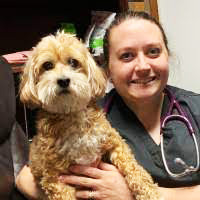
This article was updated on August 19th, 2022
Your situation:
✓ your dog is a senior dog
✓ your dog is no longer eating
✓ your dog vomited
(If this is NOT your situation, click here.)
Your old dog no longer eating is already a cause for concern, but what does it mean if your dog also vomited? It turns out that there are a lot of different senior dog health issues that can cause your older dog to eat less & vomit. Let’s have a look.
Most Likely Causes for an Old Dog Vomiting & Not Eating

Here are some of the most common reasons causing senior dogs to vomit and stop eating:
1. Cancer
Sadly, cancer is far and away the most common cause of death in older pets. It is so frequent, that anytime an older pet is feeling ill, including not eating and vomiting, cancer is high on the differential list. Cancers that can cause dogs to stop eating and vomit include esophageal, stomach, pancreatic, intestinal, and colon cancers.
Cancers outside of the gastrointestinal tract, such as kidney cancer, also commonly cause dogs to not eat and vomit due to disruption of metabolism and endocrine functions. Any older dog that is exhibiting these signs should be seen by a veterinarian as soon as possible.
2. Kidney Disease
Another leading cause of death in senior dogs is kidney disease. When they are working well, kidneys remove wastes and extra fluid from the blood. Kidneys are very sophisticated filters that rid the body of toxins. When kidneys are not working well, substances in the blood that should be filtered out build up which results in nausea, vomiting, and feeling unwell.
Kidneys can lose up to 75% of their function before any issues are seen in routine blood work. Illness is seen and kidney failure diagnosed when the kidneys have 15% or less of their function remaining. Therefore, frequent screening tests are important for older dogs so that the condition may be diagnosed as early as possible and treated aggressively.
3. Toxin Ingestion
Dogs are known for eating anything and everything that can get into their mouth even if it is not good for them. There are plants, chemicals, and certain human foods that are toxic to dogs. Any of these products can cause them to become very sick.
Often you will see vomiting and diarrhea as some of the first signs of toxin exposure. If you think that your dog has eaten something toxic, it would be best for them to see your vet right away. Some toxins have just mild signs, and your dog will quickly recover from, while others can be very serious and even life-threatening and your dog may need to stay in the hospital for a few days to fully recover. The cost for toxin exposure treatment can be as low as $200 and in severe cases can be over $2,000+.
4. Foreign Body Obstruction
Large breed dogs are known for destroying and eating their toys or other things that they should not eat. Small breed dogs can also eat things that they shouldn’t, causing objects get stuck in their intestines. A foreign body obstruction can commonly cause your dog to vomit and eat less.
Many of these dogs will not be pooping or will be having a small amount of diarrhea. At first, they are usually eating and acting normal – they are just vomiting. As the obstruction stays, your dog may start to feel really bad and show signs that they are sick. Most dogs with a foreign body obstruction will need surgery to remove this object. Surgery can cost $1,500 to $3,000 depending on what is involved and how big the object is. Without surgery, an obstruction can be life-threatening.
5. Gastroenteritis
Gastroenteritis is an infection and inflammation in your dog’s GI system. This can cause your dog to vomit and have diarrhea. Many times, these dogs also are not eating. This is commonly seen in dogs who ate something that they shouldn’t have such as getting into the trash. Trying at-home treatment of a bland diet and probiotics can help your dog recover. If you do not see your dog improving in 24 hours or they are getting worse, they will need to see your vet. Depending on the severity of your dog’s condition this can cost over $1,000.
6. Bloat Gastric Dilatation and Volvulus GDV
This is the medical term for bloat. Deep chested dogs are prone to developing GDV. This occurs when your dog eats too fast and their stomach flips over. These dogs’ abdomen will quickly become enlarged. This is a medical emergency, and you should take your dog to the vet right away.
Common signs seen in dogs with bloat are:
- difficulty breathing
- drooling
- trying to vomit
Your vet will recommend emergency surgery to correct their bloat. This procedure can be costly and can sometimes carry a poor prognosis. Most dogs who have surgery right away have a better prognosis than dogs who wait a few hours for surgery. The cost of this procedure can easily be over $2,000.
7. Food Bloat
Some dogs love their food so much that they will engorge themselves until they are sick. They will have a very enlarged abdomen from eating so much. This can cause them to vomit. They usually will not have diarrhea and may also be acting just fine.
Usually, food bloat does not require that your dog sees your vet and will pass after 24 hours. If your dog continues to be bloated and vomiting after 24 hours, it would be best to see your vet. Also if you think that your dog has developed bloat, but not from food they need to see a vet right away.
8. Pancreatitis
Pancreatitis is inflammation of your dog’s pancreas. This is a common condition that will cause your dog to vomit and have diarrhea. Pancreatitis is caused by your dog eating a high fatty meal. Your dog will also have a very painful stomach and not eat. Pancreatitis can be treated but in severe cases can be fatal.
Sometimes your dog will need to see your vet for IV fluids and injectable medication for them to recover. For mild cases of pancreatitis, you can try at-home treatment of a bland diet but if your dog does not stop vomiting and eating after 24 hours, they will need to see your vet. The cost of this workup and treatment at your vet can be $500 to $1500+ depending on the severity of your dog’s condition.
+++
These are some of the most common reasons that your dog may have these issues. There are many other health conditions that can cause your dog to vomit, not eat, and have diarrhea. If your dog does not get better, it would be best to see your vet. They can help figure out exactly what is causing these issues and start your dog on medication to help them recover very quickly.
4 Steps You Can Take at Home to Help A Dog Who is Not Eating & Vomits
There are a few things that you can do at home to help your dog who is vomiting and not eating.
- Withhold food for 4 to 6 hours: If your dog’s stomach is upset, not giving them food for a few hours will allow their stomach to calm down. When you start to offer food again make sure it is a small amount of a bland diet.
- Entice them to eat: Some dogs will eat more willingly if they are offered human food. Things like chicken and rice. Also adding a scrambled egg to their food will help. When cooking any human food for your dog, try to make it as bland as possible. No fats, oils, butter, or seasoning should be used as this can make your dog’s stomach issue worse.
- Give them a Probiotic: If your dog is vomiting, it is possible that they have also disrupted the normal bacterial flora found in their stomach and intestines. Common probiotics that you can find at the pet store are Fortiflora and Profivex.
- Try over-the-counter gastrointestinal medications (after talking to your vet): Some gastrointestinal medications used for people can also be given to dogs. Things like Pepcid and Imodium can help dogs with gastrointestinal issues. Pepcid can help decrease the gastric acid build-up and help your dog who is vomiting. Before starting any new medications ask your vet to make sure your dog can take these medications.
When Should I Call My Vet?
If your dog does not start to improve with at-home treatment after 12 to 24 hours, they should see their vet. Some conditions are considered medical emergencies and owners should not try any at-home treatment. Listed below are other conditions that would indicate that you need to skip the at-home treatment and see your vet right away.
- Bloody vomit
- Extremely bloody diarrhea
- Very lethargic
- Seizures
- Difficulty breathing
- Pale gums
- Bloated abdomen
- Bleeding that you cannot get to stop
- Vomiting for more than 24 hours or more than 4 times a day
Senior dogs experiencing any of these issues should see their vet right away. These signs can indicate a serious, even life-threatening health condition.
Read more:
Disclaimer: This website's content is not a substitute for veterinary care. Always consult with your veterinarian for healthcare decisions. Read More.



Be the first to comment